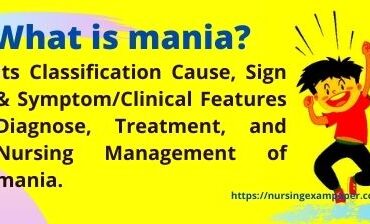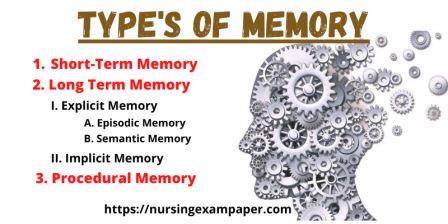In this article, you read about. What is mania? Its Classification Causes, Signs and symptoms / Clinical Features, Diagnosis, Treatment of mania, and Nursing Management of mania.
Mania is a psychological condition that causes a person to experience very intense mood, hyperactivity, inappropriate euphoria, abnormally elevated arousal, affect, energy level, and delusions. Mania is a mental and behavioral disorder, also known as manic syndrome.
During a manic episode, a person will experience rapidly changing emotions and moods, highly influenced by the surrounding stimuli. Although mania is often thought of as a “mirror image” for depression, the heightened mood can be either euphoric or dysphoric. As mania intensifies, irritability may become more pronounced and result in anxiety or anger.
Classification of mania
Mania is classified as the following
- Hypomania: It is similar to mania but less severe than mania that lasts a day and does not impair the ability to function
- Mania without psychotic symptoms :
- Elevated mood or irritability.
- Hyperactivity
- Pressure & speech.
- Decrease sleep
- Social disinhibition
- Poor attention.
- Grandiose ideas
- Extravagant schemes and over-spending.
- Mania with psychotic symptoms:
- As above or previous.
- Sever excitement.
- Flight of ideas
- Mood congruent delusion or hallucination.
Causes of mania
The exact cause is unknown, but there are several factors involved such as :
- Genetic factors.
- Biochemical factors such as neurotransmitter abnormality. (Adrenaline, Serotonin, Dopamine, etc.)
- Use of stimulants such as drugs or alcohol.
- High levels of stress such as bereavement and violence and difficult condition. like- (Physical or sexual abuse, Divorce or breakup, financial loss, Death of a loved one.)
- Neurological abnormality (Brain injury, stroke, brain tumors, dementia, insomnia)
Osteoporosis || Causes, Risk Factor, Management
Sign and Symptom / Clinical feature of mania
- Persistently elevated excitement, affect, energy level, very intense mood, hyperactivity, and confusion.
- Inflated self-esteem or grandeur.
- Hyperactivity or psychomotor agitation.
- Lack of sleep.
- Take the pressured speech more active
- Flight of Ideas
- Poor concentration and attention.
- Habit of spending excessively.
- Hypersexuality or excessive sexual activity.
- Inappropriate dress with bright colors.
- Excessive makeup and jewelry.
- distraction
- Lack of insight.
- Reduce food intake.
How to diagnose mania
- Experience at list three of the above-given signs & symptoms.
- History.
- Physical and laboratory examination.
- Psychotic examination.
Preeclampsia in Pregnancy Signs Symptoms
Complication of mania
- Legal problem.
- Injures.
- Financial problem.
- Impairment of equipment.
- Loss of body weight.
- Poor performance in work or any assignment.
- Suicidal thoughts and attempts (hypomania).
Treatment of mania
- Pharmacologic therapy:
- Mood stabilizer:
- Lithium 900 – 2100 mg\day .
- Carbamazepine 600 – 1800 mg\day.
- Sodium valproate 600 – 2600 mg\day.
- Electroconvulsion therapy.
- Mood stabilizer:
- For acute manic excitement Psychosocial therapy.
Nursing management of mania
Pericardial Effusion Symptom Diagnosis Treatment
- High risk for injury related to extreme hyperactivity and impulsive behavior, evidenced by lack of control over purposeless and potentially injurious movements :
- Keep environmental stimuli to a minimum, assign a single room, limit interaction with others, keep lighting and noise levels low. Keep his room and immediate environment minimally furnished.
- Remove hazardous objects and substances, caution the patient when there is the possibility of an accident.
- Assist the patient to engage in activities, such as writing, drawing, and other physical exercises.
- Stay with the patient as hyperactivity increases.
- Administer medication as prescribed by the physician.
- High risk for violence, self-directed or directed others are related to manic excitement, delusional thinking, and hallucination.
- Maintain la ow level of stimuli in patients’ environment, provide an unchallenged environment.
- Observe patient behavior at least every 15 minutes.
- Ensure that all harmful objects like sharp things, glass or mirror accessories, belts, ties, matches are removed from the patient’s surroundings.
- Redirect violent behavior with a physical outlet.
- Encourage verbal expression of feelings.
- Engage him in some physical exercises like aerobics.
- Maintain and convey a calm attitude to the patient. Respond matter of factly to verbal hostility. Talk to him in a low, calm voice, use clear and direct speech.
- It is associated with altered nutrition, refusal or inability to sit for long periods of time to eat less than the body needs, weight loss, and anorexia.
- Provide high protein, high calorie, nutritious foods and drinks that can be consumed while running.
- Find out the likes and dislikes of outpatients and provide preferred meals.
- Give 6 – 8 glasses of fluids daily. Have juice and snacks at all times during meals.
- Maintain patient intake and output charts. Record the calories given as per the daily requirement.
- Records patient’s weight regularly.
- A dietary supplement with vitamins and minerals.
- Walk or sit with the patient while eating.
- Self-esteem disturbance related to dependency needs, lack positive feedback, unrealistic self-expectations.
- Ask how clients would like to be addressed. Avoid approaches that imply different perceptions of client importance.
- Explain the rationale for requests by staff unit routine etc. strictly adhere to courteous approaches, matter-of-fact style, and friendly attitudes.
- Encourage verbalization and identification of feelings related to issues of chronicity, lack of control over self, etc.
- Offer matter-of-fact feedback regarding unrealistic plans. Help him to set realistic goals for himself.
- Alter family process related to euphoric mood and grandiose ideas, manipulative behavior, refusal to accept responsibility for own actions.
- Determine individual situation and feelings of individual family members like guilt, anger, powerlessness, despair





